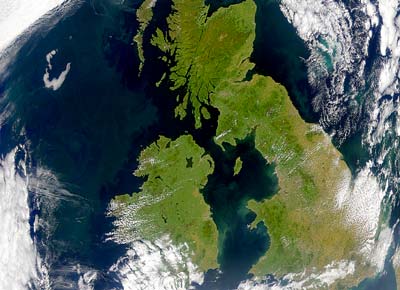British space policy on life, the universe, and everythingby Michael Huang
|
| Opponents of human spaceflight have maintained the status quo for decades. Even a small, internationally cooperative spaceflight program will meet entrenched political opposition. |
This is remarkable because all the other major powers in the world are involved with human spaceflight to some degree. Among the permanent members of the United Nations Security Council, the United States, Russia, and China have the independent capability of launching manned spacecraft, and France is a major partner in the European Space Agency’s manned flight program. In the Group of Eight (G8), again the United Kingdom is the only nation that opposes humans in space and prohibits governmental participation of any kind.
There is support in Britain for a move away from a robot-only space policy towards a more inclusive program of robotic and human space exploration. Media reports, expert opinion, and parliamentary committees have all proposed ending the ban on British astronauts. In addition, British entrepreneurs like Richard Branson are leading the way for private human spaceflight within the emerging suborbital space travel industry.
Running against this trend is a significant group of opponents which argues forcefully against the very concept of human life in space. Opponents of human spaceflight have maintained the status quo for decades. Even a small, internationally cooperative spaceflight program will meet entrenched political opposition.
The concern that human spaceflight will lead to the decline and end of robotic spaceflight and space science is unfounded. Any nation that has the launch capabilities and resources for a heavy manned spacecraft will also launch multiple light unmanned spacecraft. The fortunes of unmanned and manned programs tend to rise and fall together.
Britain does not fund launch vehicles or human spaceflight, and its spending on robotic spaceflight is correspondingly modest. The reason why Americans lead the world in civil space activities is due to the substantial investments made during the space race, especially Apollo—investments that benefited launch technologies, space science and human spaceflight. If the space race never occurred, and the astronauts never went to the Moon, NASA and its activities—including its scientific activities—would be a fraction of what they are today.
Recent cuts in astronomy and physics research funding in the UK have led to calls to stop human spaceflight, despite the fact that spaceflight has nothing to do with the cuts. The demand to stop human spaceflight must be a pre-emptive move, because the British government gives nothing to human spaceflight, and has given nothing for decades. There is nothing to cut from the human spaceflight budget because it does not exist. If a spaceflight budget existed, it would have gone through the same round of detrimental cuts as those imposed on the physics and astronomy budget.
| Teaching students to oppose and eliminate human spaceflight gives space education a whole new meaning. |
BNSC’s space policy publication, UK Civil Space Strategy: 2008-2012 and beyond, almost avoids all discussion of human spaceflight altogether, despite the renewed media and public interest in the issue. The only firm commitment made in the publication is a promise to review the 1986 decision to reject human space missions. This review comes on the heels of the Global Exploration Strategy (May 2007) and the Report of the UK Space Exploration Working Group (September 2007). Media reports say that the review will take up to a year to publish its findings. If the review is a genuine redirection of space policy regarding spaceflight, it is a welcome sign. But the review could be a bureaucratic tactic to delay and bury spaceflight in committee meetings and red tape.
Space enthusiasts will be pessimistic after seeing an old educational document on BNSC’s website. Cryosat Mission Lesson Plans and Worksheets has Extension Activities with the following instructions:
Choose one activity.
If you have time, choose a second activity from a different group of questions.2. Make the case for ending human space flight. Outline the advantages of using satellites and the disadvantages and dangers of manned missions. Include an explanation as to why manned missions have continued despite the cost and loss of life.
Seeing that both the Cryosat mission and BNSC are not involved with any aspect of human spaceflight, the question is why this topic is being raised at all in educational material. And if the human spaceflight debate had to be included, it should have been presented in a neutral and unbiased way. Teaching students to oppose and eliminate human spaceflight gives space education a whole new meaning.
The anti-human-spaceflight campaign has been described as a generational rebellion, reacting against the human spaceflight culture of the fifties and sixties. But as this rebellious generation has grown up and become the new establishment, it should expect that a new generation will reject its ideas just as completely.
